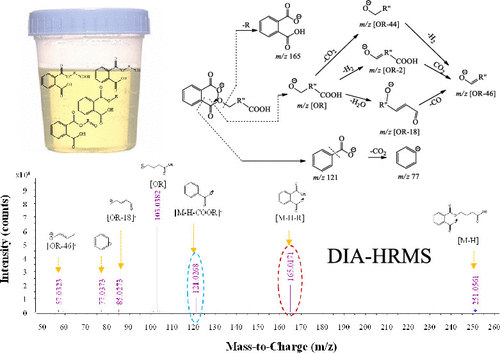当前位置:
X-MOL 学术
›
ACS Environ. Au
›
论文详情
Our official English website, www.x-mol.net, welcomes your
feedback! (Note: you will need to create a separate account there.)
Diagnostic Fragmentation Pathways for Identification of Phthalate Metabolites in Nontargeted Analysis Studies
ACS Environmental Au ( IF 6.7 ) Pub Date : 2022-05-19 , DOI: 10.1021/jasms.2c00052 Yong-Lai Feng 1 , Randolph Singh 2 , Alex Chao 3 , Yan Li 1
ACS Environmental Au ( IF 6.7 ) Pub Date : 2022-05-19 , DOI: 10.1021/jasms.2c00052 Yong-Lai Feng 1 , Randolph Singh 2 , Alex Chao 3 , Yan Li 1
Affiliation

|
Phthalates have been studied due to their linkages with adverse developmental effects; however, metabolites of this class of compounds are undercharacterized and are poorly captured by traditional targeted analysis. In this study, we developed a nontargeted analysis approach for identifying and classifying phthalate metabolites based on a comprehensive study of their fragmentation pathways in electrospray ionization (ESI) quadrupole-time-of-flight mass spectrometry (QTOF-MS). This approach identifies molecular features in the data as phthalate metabolites via the detection of three structurally significant fragment ions. Then phthalate metabolites are classified into four types based on the presence of additional fragment ions specific to each type. Cleavage mechanisms for each class of phthalate metabolite are proposed based on fragmentation patterns generated at various collision energies (CE). All of the tested phthalate metabolites including oxidative and nonoxidative metabolites produced a fragment ion at m/z 121.0295, representing the deprotonated benzoate ion [C6H5COO]−. Most tested phthalate metabolites can produce a specific ion at m/z 147.0088, the deprotonated o-phthalic anhydride ion. However, phthalate carboxylate metabolites can only produce the [M–H–R]− ion at m/z 165.0193 and do not produce the fragment at m/z 147.0088. Other phthalate oxidative metabolites (hydroxyl- and oxo-) follow a different fragmentation pathway than nonoxidative metabolites. With this workflow, eight unknown phthalate metabolites were putatively identified in pooled urine, with one identified as a previously unreported metabolite by a combination of the MS/MS spectrum and the predicted retention time. Method detection limits for phthalate metabolites in urine were also estimated.
中文翻译:

非靶向分析研究中邻苯二甲酸酯代谢物鉴定的诊断片段化途径
由于邻苯二甲酸盐与不利的发育影响有关,因此已对其进行了研究;然而,这类化合物的代谢物特征不足,传统的靶向分析很难捕获。在本研究中,我们基于对电喷雾电离 (ESI) 四极杆飞行时间质谱 (QTOF-MS) 中的裂解途径的全面研究,开发了一种非靶向分析方法,用于识别和分类邻苯二甲酸酯代谢物。这种方法通过检测三个结构上重要的碎片离子,将数据中的分子特征识别为邻苯二甲酸酯代谢物。然后根据每种类型特有的附加碎片离子的存在,将邻苯二甲酸酯代谢物分为四种类型。基于在各种碰撞能量 (CE) 下产生的碎片模式,提出了每类邻苯二甲酸酯代谢物的裂解机制。所有测试的邻苯二甲酸酯代谢物,包括氧化和非氧化代谢物,在m / z 121.0295,代表去质子化的苯甲酸根离子[C 6 H 5 COO] -。大多数测试的邻苯二甲酸酯代谢物可以在m / z 147.0088处产生特定离子,即去质子化的邻苯二甲酸酐离子。但是,邻苯二甲酸酯羧酸盐代谢物只能在m / z 165.0193 处产生 [M–H–R] -离子,而不会在m / z处产生碎片147.0088。其他邻苯二甲酸酯氧化代谢物(羟基和氧代)遵循与非氧化代谢物不同的碎裂途径。通过该工作流程,推定在混合尿液中鉴定出八种未知的邻苯二甲酸酯代谢物,其中一种通过结合 MS/MS 谱图和预测的保留时间被鉴定为以前未报告的代谢物。还估算了尿液中邻苯二甲酸酯代谢物的方法检测限。
更新日期:2022-05-19
中文翻译:

非靶向分析研究中邻苯二甲酸酯代谢物鉴定的诊断片段化途径
由于邻苯二甲酸盐与不利的发育影响有关,因此已对其进行了研究;然而,这类化合物的代谢物特征不足,传统的靶向分析很难捕获。在本研究中,我们基于对电喷雾电离 (ESI) 四极杆飞行时间质谱 (QTOF-MS) 中的裂解途径的全面研究,开发了一种非靶向分析方法,用于识别和分类邻苯二甲酸酯代谢物。这种方法通过检测三个结构上重要的碎片离子,将数据中的分子特征识别为邻苯二甲酸酯代谢物。然后根据每种类型特有的附加碎片离子的存在,将邻苯二甲酸酯代谢物分为四种类型。基于在各种碰撞能量 (CE) 下产生的碎片模式,提出了每类邻苯二甲酸酯代谢物的裂解机制。所有测试的邻苯二甲酸酯代谢物,包括氧化和非氧化代谢物,在m / z 121.0295,代表去质子化的苯甲酸根离子[C 6 H 5 COO] -。大多数测试的邻苯二甲酸酯代谢物可以在m / z 147.0088处产生特定离子,即去质子化的邻苯二甲酸酐离子。但是,邻苯二甲酸酯羧酸盐代谢物只能在m / z 165.0193 处产生 [M–H–R] -离子,而不会在m / z处产生碎片147.0088。其他邻苯二甲酸酯氧化代谢物(羟基和氧代)遵循与非氧化代谢物不同的碎裂途径。通过该工作流程,推定在混合尿液中鉴定出八种未知的邻苯二甲酸酯代谢物,其中一种通过结合 MS/MS 谱图和预测的保留时间被鉴定为以前未报告的代谢物。还估算了尿液中邻苯二甲酸酯代谢物的方法检测限。









































 京公网安备 11010802027423号
京公网安备 11010802027423号